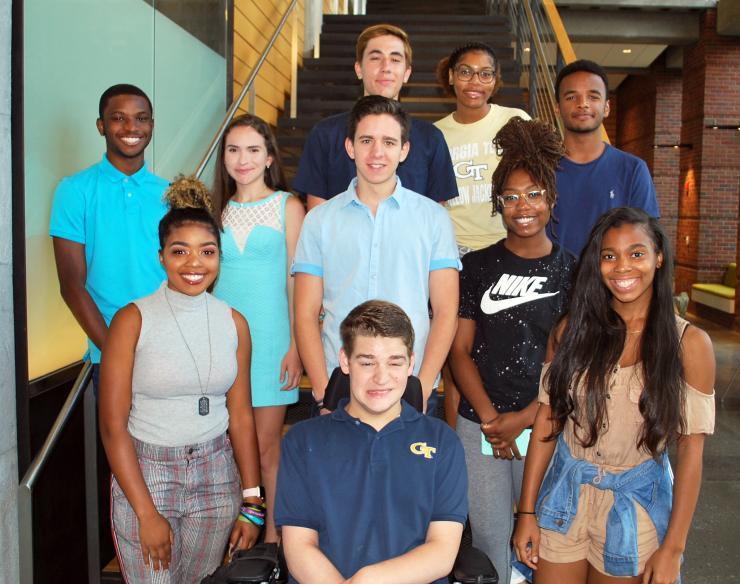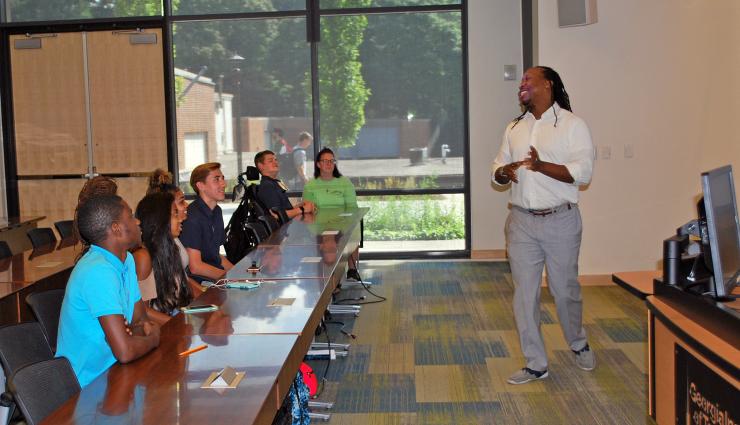ESTEEMED Program Blasts Off
Sep 14, 2018 — Atlanta, GA

Introducing the first cohort of ESTEEMED scholars.
Front row (L-R): Alexandria Neal, Trey Quinn, and Zaria Hardnett. Middle row (L-R): Clinton Smith, Rhiannon Wackes Meléndez, Giancarlo Riccobono, and Kaiya Mitchell. Back row (L-R): Thiago Esslinger, Cayla Jones, and Nathan Haileyesus.
Ten freshmen are blazing a new trail and making history at the Georgia Institute of Technology as the inaugural cohort of students in one of the nation’s first two ESTEEMED programs, supported by the National Institutes of Health (NIH) and designed to increase diversity in the biomedical research workforce.
“It’s exciting that they only chose two programs from this first round of funding, and we are one of them,” said Manu Platt, an associate professor in the Wallace H. Coulter Department of Biomedical Engineering, who is directing the program.
The other ESTEEMED program is also based in Georgia at Savannah State University, the oldest HBCU (Historically Black College and/or University) in the state.
“I think this speaks highly of Georgia Tech, its commitment to diversity, and the historic record we have of demonstrating this commitment for a new and highly experimental program,” added Platt, a researcher in the Petit Institute for Bioengineering and Bioscience, whose co-investigators in the ESTEEMED program are Wendy Newstetter and Cassie Mitchell, both faculty members of the Coulter Department. Mitchell is also a Petit Institute researcher while Newstetter is assistant dean iof educational research and innovation in the College of Engineering.
ESTEEMED, which stands for ‘Enhancing Science, Technology, EnginEering, and Math Educational Diversity,’ is a five-year, $1.7 million program funded by the National Institute of Biomedical Imaging and Bioengineering (NIBIB, a division of NIH) that supports early preparation in undergraduate education in STEM fields. According to Platt, the goal is to have an impact on groups historically underrepresented in STEM, groups that include racial/ethnic minorities, people with disabilities, those from underprivileged backgrounds, and intersections of these categories.
The first cohort of students, who gathered for a fall semester ESTEEMED orientation meeting on Tuesday, Sept. 11, are: Thiago Esslinger, biochemistry; Nathan Haileyesus, biomedical engineering; Zaria Hardnett, neuroscience; Cayla Jones, chemistry; Kaiya Mitchell, biomedical engineering; Alexandria Neal, chemistry; Trey Quinn, computer science; Giancarlo Riccobono, biomedical engineering; Clinton Smith, biomedical engineering; Rhiannon Wackes Meléndez, biomedical engineering.
These students were part of an ESTEEMED required ‘Summer Bridge Program,’ helping to ease the transition to college life, something Platt experienced when he was a new student at Morehouse College, and the inspiration for the grant he submitted to NIH almost two years ago.
“I was in a pre-freshman summer program at Morehouse and I equate a lot of my success with that,” said Platt, who finished high school in Delaware. “I came down the summer before my freshman year and met the best friends of my life. It was very helpful, something I didn’t realize at the time – you do it because it’s part of your scholarship, but then you realize later what a big impact it had.”
He’s hoping the scholars embarking on the ESTEEMED journey will realize the impact sooner. There’s a lot expected from these students. Participants are expected to eventually enter an advanced honors program for juniors and seniors, which aims to prepare them for doctoral programs in biomedical research fields.
Student expectations and mandatory activities include: cohort study sessions; individual and small group meetings with professors; extended, mentored lab research experiences; journal club reading; leadership opportunities; blogging assignments; travel to and participation in national science research conferences; and other professional development opportunities.
“This is a new program, a new model, and we want to have an early impact that can be sustained,” Platt said. “We want that jump from high school to college to be great, so that they land with excellent GPA’s. And we want to break down the barriers between students and faculty, so that they see faculty as their friends.”
Faculty lunches with ESTEEMED scholars will help break down those barriers, and the students’ laboratory research experiences will be enhanced by the participation of grad students and postdocs who will serve as mentors.
Platt also expects the students’ participation in science conferences and workshops will provided a critical added value.
“Those experiences will expose them to difference science and scientists,” he said. “It will spark their imaginations and help them realize that a career in biomedical research is an excellent idea.”

Manu Platt addresses the new cohort of ESTEEMED scholars.
Jerry Grillo
Communications Officer II
Parker H. Petit Institute for
Bioengineering and Bioscience




